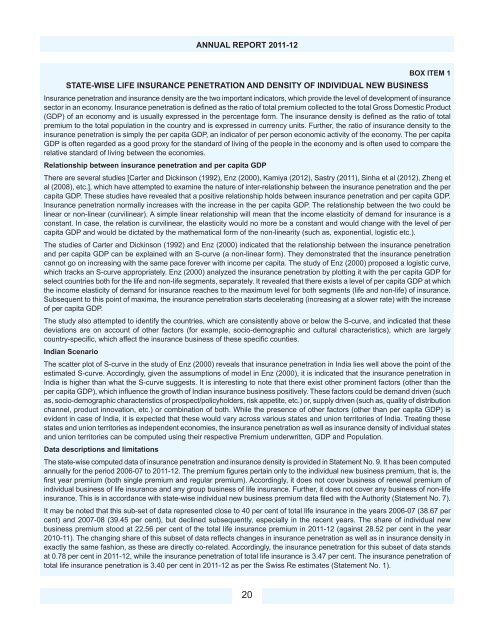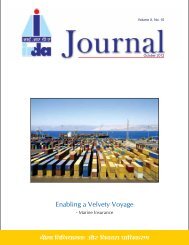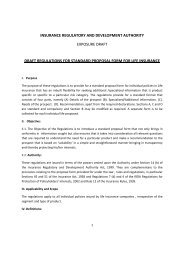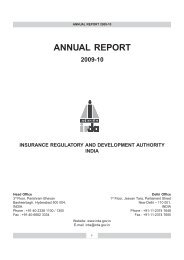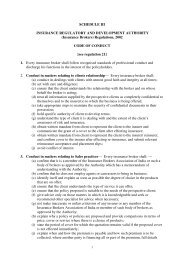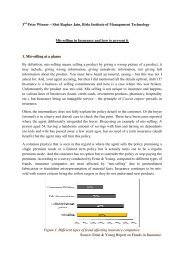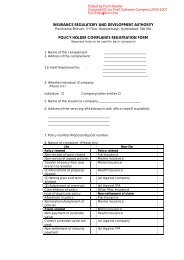Download PDF - IRDA
Download PDF - IRDA
Download PDF - IRDA
Create successful ePaper yourself
Turn your PDF publications into a flip-book with our unique Google optimized e-Paper software.
ANNUAL REPORT 2011-12<br />
STATE-WISE LIFE INSURANCE PENETRATION AND DENSITY OF INDIVIDUAL NEW BUSINESS<br />
BOX ITEM 1<br />
Insurance penetration and insurance density are the two important indicators, which provide the level of development of insurance<br />
sector in an economy. Insurance penetration is defined as the ratio of total premium collected to the total Gross Domestic Product<br />
(GDP) of an economy and is usually expressed in the percentage form. The insurance density is defined as the ratio of total<br />
premium to the total population in the country and is expressed in currency units. Further, the ratio of insurance density to the<br />
insurance penetration is simply the per capita GDP, an indicator of per person economic activity of the economy. The per capita<br />
GDP is often regarded as a good proxy for the standard of living of the people in the economy and is often used to compare the<br />
relative standard of living between the economies.<br />
Relationship between insurance penetration and per capita GDP<br />
There are several studies [Carter and Dickinson (1992), Enz (2000), Kamiya (2012), Sastry (2011), Sinha et al (2012), Zheng et<br />
al (2008), etc.], which have attempted to examine the nature of inter-relationship between the insurance penetration and the per<br />
capita GDP. These studies have revealed that a positive relationship holds between insurance penetration and per capita GDP.<br />
Insurance penetration normally increases with the increase in the per capita GDP. The relationship between the two could be<br />
linear or non-linear (curvilinear). A simple linear relationship will mean that the income elasticity of demand for insurance is a<br />
constant. In case, the relation is curvilinear, the elasticity would no more be a constant and would change with the level of per<br />
capita GDP and would be dictated by the mathematical form of the non-linearity (such as, exponential, logistic etc.).<br />
The studies of Carter and Dickinson (1992) and Enz (2000) indicated that the relationship between the insurance penetration<br />
and per capita GDP can be explained with an S-curve (a non-linear form). They demonstrated that the insurance penetration<br />
cannot go on increasing with the same pace forever with income per capita. The study of Enz (2000) proposed a logistic curve,<br />
which tracks an S-curve appropriately. Enz (2000) analyzed the insurance penetration by plotting it with the per capita GDP for<br />
select countries both for the life and non-life segments, separately. It revealed that there exists a level of per capita GDP at which<br />
the income elasticity of demand for insurance reaches to the maximum level for both segments (life and non-life) of insurance.<br />
Subsequent to this point of maxima, the insurance penetration starts decelerating (increasing at a slower rate) with the increase<br />
of per capita GDP.<br />
The study also attempted to identify the countries, which are consistently above or below the S-curve, and indicated that these<br />
deviations are on account of other factors (for example, socio-demographic and cultural characteristics), which are largely<br />
country-specifi c, which affect the insurance business of these specifi c counties.<br />
Indian Scenario<br />
The scatter plot of S-curve in the study of Enz (2000) reveals that insurance penetration in India lies well above the point of the<br />
estimated S-curve. Accordingly, given the assumptions of model in Enz (2000), it is indicated that the insurance penetration in<br />
India is higher than what the S-curve suggests. It is interesting to note that there exist other prominent factors (other than the<br />
per capita GDP), which influence the growth of Indian insurance business positively. These factors could be demand driven (such<br />
as, socio-demographic characteristics of prospect/policyholders, risk appetite, etc.) or, supply driven (such as, quality of distribution<br />
channel, product innovation, etc.) or combination of both. While the presence of other factors (other than per capita GDP) is<br />
evident in case of India, it is expected that these would vary across various states and union territories of India. Treating these<br />
states and union territories as independent economies, the insurance penetration as well as insurance density of individual states<br />
and union territories can be computed using their respective Premium underwritten, GDP and Population.<br />
Data descriptions and limitations<br />
The state-wise computed data of insurance penetration and insurance density is provided in Statement No. 9. It has been computed<br />
annually for the period 2006-07 to 2011-12. The premium figures pertain only to the individual new business premium, that is, the<br />
first year premium (both single premium and regular premium). Accordingly, it does not cover business of renewal premium of<br />
individual business of life insurance and any group business of life insurance. Further, it does not cover any business of non-life<br />
insurance. This is in accordance with state-wise individual new business premium data filed with the Authority (Statement No. 7).<br />
It may be noted that this sub-set of data represented close to 40 per cent of total life insurance in the years 2006-07 (38.67 per<br />
cent) and 2007-08 (39.45 per cent), but declined subsequently, especially in the recent years. The share of individual new<br />
business premium stood at 22.56 per cent of the total life insurance premium in 2011-12 (against 28.52 per cent in the year<br />
2010-11). The changing share of this subset of data refl ects changes in insurance penetration as well as in insurance density in<br />
exactly the same fashion, as these are directly co-related. Accordingly, the insurance penetration for this subset of data stands<br />
at 0.78 per cent in 2011-12, while the insurance penetration of total life insurance is 3.47 per cent. The insurance penetration of<br />
total life insurance penetration is 3.40 per cent in 2011-12 as per the Swiss Re estimates (Statement No. 1).<br />
20


